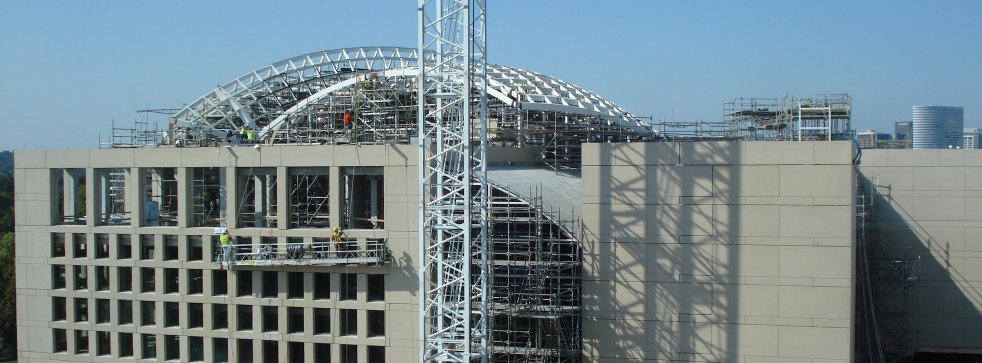I am on a panel about public diplomacy at the Second Public Diplomacy Symposium at Syracuse University in Syracuse, New York on October 16. Since it is a panel DISCUSSION I don’t want to say too much initially in order to let the discussion develop in ways favored by the participants. The reflections on public diplomacy on the blog this week are some of the ways I am working through the issues. Sorry for all the overlap. I have to produce hours of thought to yield a few minutes of talk. It takes a lot of preparation to be spontaneous.
Below is what I plan to use as an introduction. The PowerPoint for the presentation is available at this link.
Social Media & Public Diplomacy

Above are workers constructing the new Institute of Peace building across from my office. They use a variety of tools for their work, choosing the most appropriate for the job at hand. The TASK is the important thing. The tools are just a way to get the job done. A carpenter does not have a specific “hammer strategy.” We should not have a specific Facebook or Twitter strategy. Our PD TOOLS should be used … as tools – part of a tool box or portfolio. Use the ones that work at the right place and time; don’t develop a strategy for them.
****
You are catching me at a time of indecision. I spent more than twenty-five years working in public diplomacy and have been a pioneer in State Department innovative use of the new media; at least they gave me a couple awards that said so. But I have doubts. Electronic distribution & the social/interactive media is not the game changer I hoped. On reflection, I think we leaned too much about technology and not enough on the social and anthropological aspects of the social media. Technology has made it easy to reach large numbers of people, but it doesn’t mean they are paying attention, turning our information into useful knowledge or doing something new or different based on what they get from us.
We have to do a lot of rethinking but it is hard to think when we are beguiled and distracted by the promise of technology. So let’s set aside all the latest techno-developments and think about the SOCIAL media from the human and audience perspective. Since this will be a DISCUSSION and I have only a few minutes to provoke your questions, let me give you the seven truths about public diplomacy and social media.
1. Social – less about technologies and more about social interactions with people.
2. Iterative – It is a continuous learning, iterative process, not a plan and not something that can be delegated or finished.
3. Engaged – You want to influence others AND you are willing to be influenced by others.
4. Community -based – Build a community & be part of a community. Figure out what you can contribute to the community. People make decisions in the contexts of their communities.
5. Simultaneously Inclusive & Exclusive – A community is both inclusive of its members and exclusive to others. You attract nobody if you appeal to everybody. You have to earn membership in any community worth being a member.
6. Personal – Editors and marketers have tried for years to homogenize for the mass market. Niche markets – and the new media is just a series of niche markets – requires personality. There is no such thing as a world product. Even the ubiquitous Coca-Cola varies by region and country. We engage a series of niche markets. This means that we have to work through our country-posts, with people immersed in local cultures, politics and sensibilities and has obvious implications for a Washington-based PD messaging strategy.
7. Fun – We underestimate the importance of fun & games. People have choices in the new media. They often engage because it is fun and if you bore them they will wander off.
So these are the things that I think shape our use of social media. Let’s talk.
